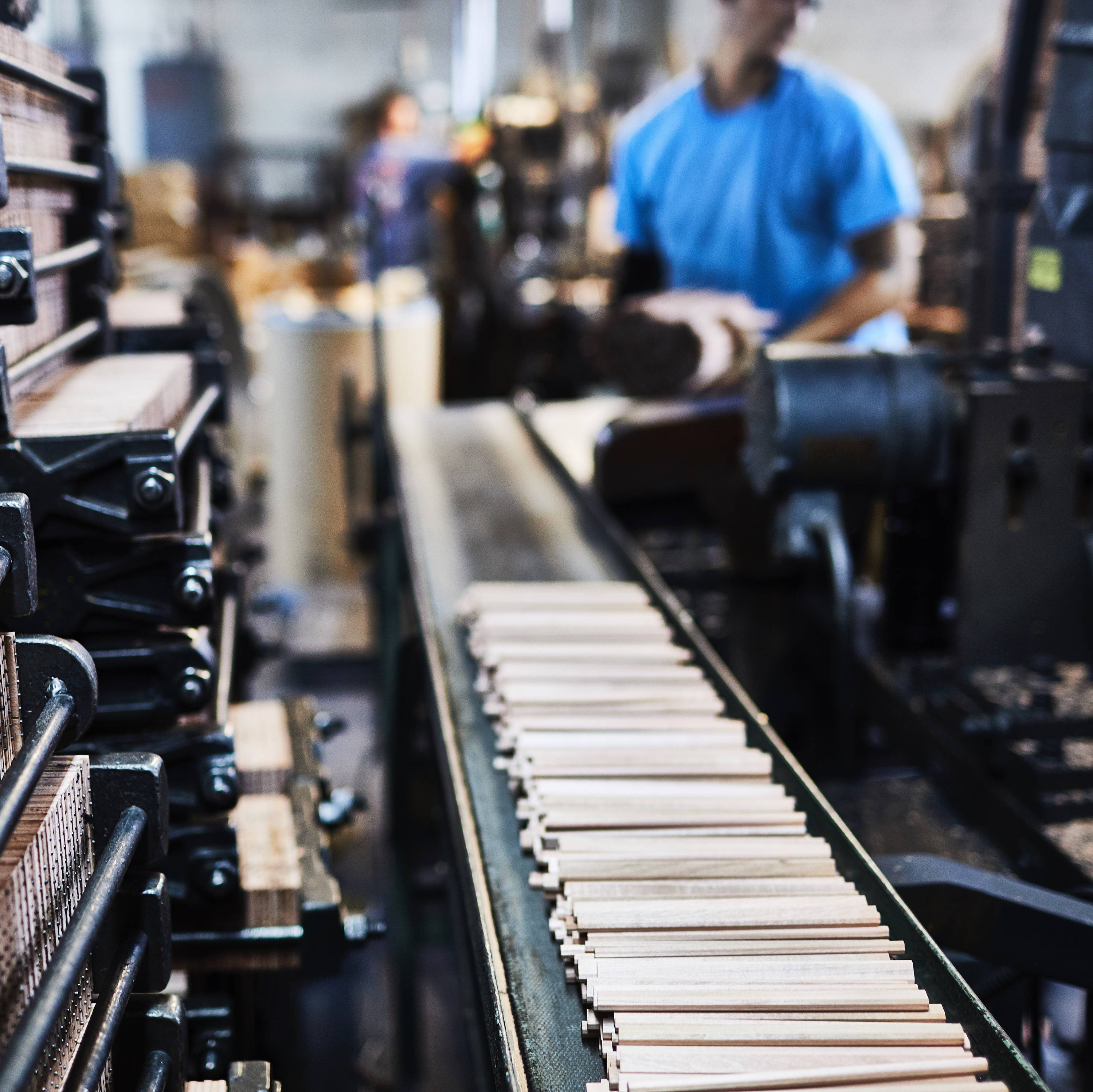There are plenty of places on the web where you’re told how a pencil is made, but have you really ever had a chance to see it in action at a factory like Musgrave Pencil Company?!
And while we wish we could welcome you through our doors to see it in person (alas, we don’t offer tours of our pencil factory for safety reasons), we can show you some amazing close-ups of our machines hard at work making custom made in the USA pencils.
But before we dive in, it’s helpful to see a visual of the production process. First things first: Think of a pencil like a sandwich. It’s made up of a single graphite core sandwiched between two slices of wood, held together with glue. Once that “sandwich” is made, it’s sent through machines for cutting, shaping, painting, printing, and tipping (set with an eraser and a ferrule).
Illustration by Studio Delger
So let’s dive in and see a pencil being made on our amazing machinery here at Musgrave!
Our Pencil Factory
This is where it all begins — our factory in Shelbyville, Tennessee. We’ve been making custom pencils here in the USA for more than 100 years.
Wooden Pencil Slats
We start with wooden slats. These arrive in our factory in stacks upon stacks.
Wooden Slats Get Grooves
Each individual slat goes through a machine called the Groover Machine (not to be confused with someone who can’t stop dancing) that cuts — you guessed it — grooves into the surface of the wood. This preps the wood for graphite.
Graphite Laid Into Grooves
Next we lay the graphite cores of the pencils into the snug grooves on the slat. Each gets a thin layer of glue, and one by one, graphite cores are laid into the grooves that were earlier cut into our pencil slats. Most of our cores are made up of a blend of raw graphite and clay, although some pencils like our Test Scoring Pencil have other materials inside the core.
Fun Fact: Graphite
Curious how graphite is made? First, the raw graphite is ground very finely. Next, it’s blended with clay and other ingredients to make a sort of paste. The paste is pushed through a thin tube, which makes the long spaghetti-strand shape of the pencil’s core. It’s fired in an oven, dried, and ready to be put in a pencil. This close-up clip shows the pencil cores moving quickly through our machines.
Pencil Slats Become Wood-Cased
Next, the graphite is sandwiched together with another slat. While it’d be impossible to write with it at this point, you are seeing the very first step of an officially “wood cased” pencil.
Pencils Clamped Overnight
The freshly glued slats are clamped together and left overnight to dry, ensuring everything is stuck tightly together.
Wood-Cased Slats Cut Into Pencils
Since they’re still slat sandwiches, our next stop is shaping the slats into pencils. Slats are laid into a cutting machine that divides each one evenly. Now they’re looking like a #2!
Fun Fact: Pencil Shapes
The body of a pencil is called a “barrel.” Here at Musgrave, we make a variety of pencil styles: Round, Hex, Jumbo, Carpenter, Bridge, and Golf, all of which are available as custom pencils. These standard pencils are moving down our conveyor belt, ready for a coat of paint.
Raw Pencils Are Painted
After cutting, it’s time to give them a coat of paint. Everyone loves a classic yellow pencil, but we have virtually endless options for pencil colors in our factory for custom pencil orders because we can mix our paint to an exact Pantone® match! Depending on the style of pencil, they’ll get between 4 and 10 coats of paint.
Pencils Get Printed
Now that they’re painted, it’s time to give our pencils some flair. From here they will head to one of our many printing methods: Some will get hot foil lettering imprinted on the side, others will get digital printing, a full foil wrap around the barrel, or screen printed. As a pencil factory, we can accommodate the production of nearly any kind of custom pencil order.
Pencils Tipped with Eraser and Ferrule
Once the pencils are painted, printed, or wrapped in the customer’s style, they are tipped, which means they get a ferrule and eraser (unless, of course, customers order them without). In a quick, four-step process, the pencils' ends are primed, set with a ferrule, then eraser, then clamped together.
Fun Fact: Golf Pencils
During the tipping process, our Golf pencils have an especially funky step — they get an eraser and ferrule on BOTH ends, prior to being cut in half to make them pocket-sized.
Pencils Are Sharpened
Some of our pencils get a further step — sharpening! We use a belt sander to grind down the tip of the pencil into a nice fine point.
Pencils Are Quality Checked
The pencils are checked in our Quality Control department, making sure there are no misprints, missing ferrules, or other problems.
Pencils Are Boxed
Have we talked about boxes yet? Custom orders can be packaged nicely in custom-printed boxes at our box factory next door, giving the newly minted pencils a tidy package to travel in.
Pencils Are Put To Use!
When our pencils arrive in our customer’s hands, they continue to transform. These pencils are fresh off the press, but the little shavings remind us the next stage of their journey is now with you. From big bold ideas sketched out in a notebook, to a child learning how to write their ABC’s, it’s almost too easy to romanticize how cool pencils are!
Love this series? We're always posting great images and videos of our custom pencils on our Instagram. Follow the hashtag #TheMakingOfAPencil for footage from our factory showing how a pencil is made.
Special thanks to Emily Dorio for photography.
